《数据库系统概念 Database System Concepts》原书教学资源(第六版,PPT课件讲稿,英文版)Chapter 18 Parallel Databases
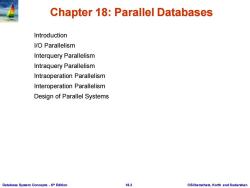
Chapter 18:Parallel Databases Introduction /O Parallelism Interquery Parallelism Intraquery Parallelism Intraoperation Parallelism Interoperation Parallelism Design of Parallel Systems Database System Concepts-6th Edition 18.2 @Silberschatz,Korth and Sudarshan
Database System Concepts - 6 18.2 ©Silberschatz, Korth and Sudarshan th Edition Chapter 18: Parallel Databases Introduction I/O Parallelism Interquery Parallelism Intraquery Parallelism Intraoperation Parallelism Interoperation Parallelism Design of Parallel Systems
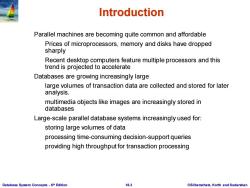
Introduction Parallel machines are becoming quite common and affordable Prices of microprocessors,memory and disks have dropped sharply Recent desktop computers feature multiple processors and this trend is projected to accelerate Databases are growing increasingly large large volumes of transaction data are collected and stored for later analysis. multimedia objects like images are increasingly stored in databases Large-scale parallel database systems increasingly used for: storing large volumes of data processing time-consuming decision-support queries providing high throughput for transaction processing Database System Concepts-6th Edition 18.3 ©Silberschat乜,Korth and Sudarshan
Database System Concepts - 6 18.3 ©Silberschatz, Korth and Sudarshan th Edition Introduction Parallel machines are becoming quite common and affordable Prices of microprocessors, memory and disks have dropped sharply Recent desktop computers feature multiple processors and this trend is projected to accelerate Databases are growing increasingly large large volumes of transaction data are collected and stored for later analysis. multimedia objects like images are increasingly stored in databases Large-scale parallel database systems increasingly used for: storing large volumes of data processing time-consuming decision-support queries providing high throughput for transaction processing

Parallelism in Databases Data can be partitioned across multiple disks for parallel 1/O Individual relational operations (e.g.,sort,join,aggregation)can be executed in parallel data can be partitioned and each processor can work independently on its own partition. Queries are expressed in high level language(SQL,translated to relational algebra) makes parallelization easier. Different queries can be run in parallel with each other. Concurrency control takes care of conflicts. Thus,databases naturally lend themselves to parallelism. Database System Concepts-6th Edition 18.4 ©Silberschat乜,Korth and Sudarshan
Database System Concepts - 6 18.4 ©Silberschatz, Korth and Sudarshan th Edition Parallelism in Databases Data can be partitioned across multiple disks for parallel I/O. Individual relational operations (e.g., sort, join, aggregation) can be executed in parallel data can be partitioned and each processor can work independently on its own partition. Queries are expressed in high level language (SQL, translated to relational algebra) makes parallelization easier. Different queries can be run in parallel with each other. Concurrency control takes care of conflicts. Thus, databases naturally lend themselves to parallelism
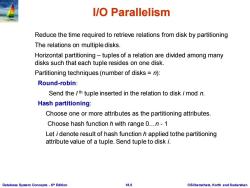
I/O Parallelism Reduce the time required to retrieve relations from disk by partitioning The relations on multiple disks. Horizontal partitioning-tuples of a relation are divided among many disks such that each tuple resides on one disk. Partitioning techniques(number of disks =n): Round-robin: Send the /th tuple inserted in the relation to disk i mod n. Hash partitioning: Choose one or more attributes as the partitioning attributes. Choose hash function h with range 0...n-1 Let i denote result of hash function h applied tothe partitioning attribute value of a tuple.Send tuple to disk i. Database System Concepts-6th Edition 18.5 @Silberschatz,Korth and Sudarshan
Database System Concepts - 6 18.5 ©Silberschatz, Korth and Sudarshan th Edition I/O Parallelism Reduce the time required to retrieve relations from disk by partitioning The relations on multiple disks. Horizontal partitioning – tuples of a relation are divided among many disks such that each tuple resides on one disk. Partitioning techniques (number of disks = n): Round-robin: Send the I th tuple inserted in the relation to disk i mod n. Hash partitioning: Choose one or more attributes as the partitioning attributes. Choose hash function h with range 0…n - 1 Let i denote result of hash function h applied tothe partitioning attribute value of a tuple. Send tuple to disk i

I/O Parallelism (Cont.) Partitioning techniques(cont.) Range partitioning: Choose an attribute as the partitioning attribute. A partitioning vector [vo,v1,...vn-2]is chosen. Let v be the partitioning attribute value of a tuple.Tuples such that viVn-2 go to disk n-1. E.g.,with a partitioning vector [5,11],a tuple with partitioning attribute value of 2 will go to disk 0,a tuple with value 8 will go to disk 1,while a tuple with value 20 will go to disk2 Database System Concepts-6th Edition 18.6 @Silberschatz,Korth and Sudarshan
Database System Concepts - 6 18.6 ©Silberschatz, Korth and Sudarshan th Edition I/O Parallelism (Cont.) Partitioning techniques (cont.): Range partitioning: Choose an attribute as the partitioning attribute. A partitioning vector [vo , v1 , ..., vn-2 ] is chosen. Let v be the partitioning attribute value of a tuple. Tuples such that vi vi+1 go to disk I + 1. Tuples with v < v0 go to disk 0 and tuples with v vn-2 go to disk n-1. E.g., with a partitioning vector [5,11], a tuple with partitioning attribute value of 2 will go to disk 0, a tuple with value 8 will go to disk 1, while a tuple with value 20 will go to disk2
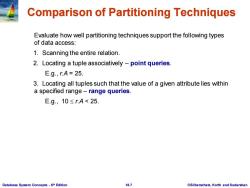
Comparison of Partitioning Techniques Evaluate how well partitioning techniques support the following types of data access: 1.Scanning the entire relation. 2.Locating a tuple associatively -point queries. E.g,r.A=25. 3.Locating all tuples such that the value of a given attribute lies within a specified range-range queries. E.g.,10≤r.A<25. Database System Concepts-6th Edition 18.7 @Silberschatz,Korth and Sudarshan
Database System Concepts - 6 18.7 ©Silberschatz, Korth and Sudarshan th Edition Comparison of Partitioning Techniques Evaluate how well partitioning techniques support the following types of data access: 1. Scanning the entire relation. 2. Locating a tuple associatively – point queries. E.g., r.A = 25. 3. Locating all tuples such that the value of a given attribute lies within a specified range – range queries. E.g., 10 r.A < 25
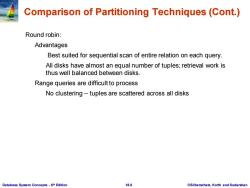
Comparison of Partitioning Techniques(Cont.) Round robin: Advantages Best suited for sequential scan of entire relation on each query. All disks have almost an equal number of tuples;retrieval work is thus well balanced between disks. Range queries are difficult to process No clustering--tuples are scattered across all disks Database System Concepts-6th Edition 18.8 @Silberschatz,Korth and Sudarshan
Database System Concepts - 6 18.8 ©Silberschatz, Korth and Sudarshan th Edition Comparison of Partitioning Techniques (Cont.) Round robin: Advantages Best suited for sequential scan of entire relation on each query. All disks have almost an equal number of tuples; retrieval work is thus well balanced between disks. Range queries are difficult to process No clustering -- tuples are scattered across all disks
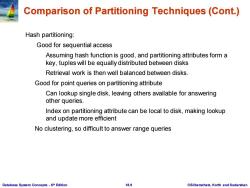
Comparison of Partitioning Techniques(Cont.) Hash partitioning: Good for sequential access Assuming hash function is good,and partitioning attributes form a key,tuples will be equally distributed between disks Retrieval work is then well balanced between disks. Good for point queries on partitioning attribute Can lookup single disk,leaving others available for answering other queries. Index on partitioning attribute can be local to disk,making lookup and update more efficient No clustering,so difficult to answer range queries Database System Concepts-6th Edition 18.9 ©Silberscha乜,Korth and Sudarshan
Database System Concepts - 6 18.9 ©Silberschatz, Korth and Sudarshan th Edition Hash partitioning: Good for sequential access Assuming hash function is good, and partitioning attributes form a key, tuples will be equally distributed between disks Retrieval work is then well balanced between disks. Good for point queries on partitioning attribute Can lookup single disk, leaving others available for answering other queries. Index on partitioning attribute can be local to disk, making lookup and update more efficient No clustering, so difficult to answer range queries Comparison of Partitioning Techniques (Cont.)
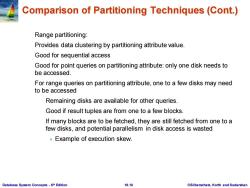
Comparison of Partitioning Techniques(Cont.) Range partitioning: Provides data clustering by partitioning attribute value. Good for sequential access Good for point queries on partitioning attribute:only one disk needs to be accessed. For range queries on partitioning attribute,one to a few disks may need to be accessed Remaining disks are available for other queries. Good if result tuples are from one to a few blocks. If many blocks are to be fetched,they are still fetched from one to a few disks,and potential parallelism in disk access is wasted Example of execution skew. Database System Concepts-6th Edition 18.10 @Silberschatz,Korth and Sudarshan
Database System Concepts - 6 18.10 ©Silberschatz, Korth and Sudarshan th Edition Comparison of Partitioning Techniques (Cont.) Range partitioning: Provides data clustering by partitioning attribute value. Good for sequential access Good for point queries on partitioning attribute: only one disk needs to be accessed. For range queries on partitioning attribute, one to a few disks may need to be accessed Remaining disks are available for other queries. Good if result tuples are from one to a few blocks. If many blocks are to be fetched, they are still fetched from one to a few disks, and potential parallelism in disk access is wasted Example of execution skew
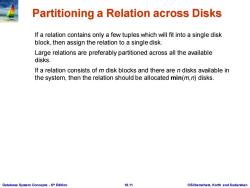
Partitioning a Relation across Disks If a relation contains only a few tuples which will fit into a single disk block,then assign the relation to a single disk. Large relations are preferably partitioned across all the available disks. If a relation consists of m disk blocks and there are n disks available in the system,then the relation should be allocated min(m,n)disks. Database System Concepts-6th Edition 18.11 @Silberschatz,Korth and Sudarshan
Database System Concepts - 6 18.11 ©Silberschatz, Korth and Sudarshan th Edition Partitioning a Relation across Disks If a relation contains only a few tuples which will fit into a single disk block, then assign the relation to a single disk. Large relations are preferably partitioned across all the available disks. If a relation consists of m disk blocks and there are n disks available in the system, then the relation should be allocated min(m,n) disks
按次数下载不扣除下载券;
注册用户24小时内重复下载只扣除一次;
顺序:VIP每日次数-->可用次数-->下载券;
- 《数据库系统概念 Database System Concepts》原书教学资源(第六版,PPT课件讲稿,英文版)Chapter 17 Database System Architectures.ppt
- 《数据库系统概念 Database System Concepts》原书教学资源(第六版,PPT课件讲稿,英文版)Chapter 16 Recovery System.ppt
- 《数据库系统概念 Database System Concepts》原书教学资源(第六版,PPT课件讲稿,英文版)Chapter 15 Concurrency Control.ppt
- 《数据库系统概念 Database System Concepts》原书教学资源(第六版,PPT课件讲稿,英文版)Chapter 14 Transactions.ppt
- 《数据库系统概念 Database System Concepts》原书教学资源(第六版,PPT课件讲稿,英文版)Chapter 13 Query Optimization.ppt
- 《数据库系统概念 Database System Concepts》原书教学资源(第六版,PPT课件讲稿,英文版)Chapter 12 Query Processing.ppt
- 《数据库系统概念 Database System Concepts》原书教学资源(第六版,PPT课件讲稿,英文版)Chapter 11 Indexing and Hashing.ppt
- 《数据库系统概念 Database System Concepts》原书教学资源(第六版,PPT课件讲稿,英文版)Chapter 10 Storage and File Structure.ppt
- 《数据库系统概念 Database System Concepts》原书教学资源(第六版,PPT课件讲稿,英文版)Chapter 1 Introduction(Avi Silberschatz Henry F. Korth S. Sudarshan).ppt
- 电子科技大学:《大数据时代商业模式创新 Business model innovation》研究生课程教学资源(课件讲稿,杜义飞).pdf
- 电子科技大学:《大数据时代商业模式创新 Business model innovation》研究生课程教学资源(讲座)换一个视角看清商业本质.pdf
- 电子科技大学:《大数据时代商业模式创新 Business Model Innovation in the Times of Big Data》研究生课程教学资源(教学大纲,杜义飞).pdf
- 《物联网技术导论 Introduction of Internet of Things》课程教学资源(参考文献)群智感知计算(清华大学:在后台操纵的同时,用户对于污染、扭曲文字的识 刘云浩).pdf
- 南京大学:《物联网技术导论 Introduction of Internet of Things》课程教学资源(参考文献)基于位置服的务(架构与研究进展).pdf
- 南京大学:《物联网技术导论 Introduction of Internet of Things》课程教学资源(参考文献)Wi-Fi雷达 - 从RSSI到CSI.pdf
- 南京大学:《物联网技术导论 Introduction of Internet of Things》课程教学资源(参考文献)Survey of Wireless Indoor Positioning Techniques and Systems.pdf
- 南京大学:《物联网技术导论 Introduction of Internet of Things》课程教学资源(参考文献)Location, Localization, and Localizability.pdf
- RFID标签数目估算机制研究(参考文献)ZOE - Fast Cardinality Estimation for Large-Scale RFID Systems.pdf
- RFID标签数目估算机制研究(参考文献)Every Bit Counts - Fast and Scalable RFID Estimation.pdf
- RFID标签数目估算机制研究(参考文献)Energy Efficient Algorithms for the RFID Estimation Problem.pdf
- 《数据库系统概念 Database System Concepts》原书教学资源(第六版,PPT课件讲稿,英文版)Chapter 19 Distributed Databases.ppt
- 《数据库系统概念 Database System Concepts》原书教学资源(第六版,PPT课件讲稿,英文版)Chapter 2 Introduction to the Relational Model.ppt
- 《数据库系统概念 Database System Concepts》原书教学资源(第六版,PPT课件讲稿,英文版)Chapter 20 Data Analysis.ppt
- 《数据库系统概念 Database System Concepts》原书教学资源(第六版,PPT课件讲稿,英文版)Chapter 21 Information Retrieval.ppt
- 《数据库系统概念 Database System Concepts》原书教学资源(第六版,PPT课件讲稿,英文版)Chapter 22 Object-Based Databases.ppt
- 《数据库系统概念 Database System Concepts》原书教学资源(第六版,PPT课件讲稿,英文版)Chapter 23 XML.ppt
- 《数据库系统概念 Database System Concepts》原书教学资源(第六版,PPT课件讲稿,英文版)Chapter 24 Advanced Application Development.ppt
- 《数据库系统概念 Database System Concepts》原书教学资源(第六版,PPT课件讲稿,英文版)Chapter 25 Advanced Data Types and New Applications.ppt
- 《数据库系统概念 Database System Concepts》原书教学资源(第六版,PPT课件讲稿,英文版)Chapter 26 Advanced Transaction Processing.ppt
- 《数据库系统概念 Database System Concepts》原书教学资源(第六版,PPT课件讲稿,英文版)Chapter 3 Introduction to SQL.ppt
- 《数据库系统概念 Database System Concepts》原书教学资源(第六版,PPT课件讲稿,英文版)Chapter 4 Intermediate SQL.ppt
- 《数据库系统概念 Database System Concepts》原书教学资源(第六版,PPT课件讲稿,英文版)Chapter 5 Advanced SQL.ppt
- 《数据库系统概念 Database System Concepts》原书教学资源(第六版,PPT课件讲稿,英文版)Chapter 6 Formal Relational Query Languages.ppt
- 《数据库系统概念 Database System Concepts》原书教学资源(第六版,PPT课件讲稿,英文版)Chapter 7 Database Design - The Entity-Relationship Approach.ppt
- 《数据库系统概念 Database System Concepts》原书教学资源(第六版,PPT课件讲稿,英文版)Chapter 8 Relational Database Design.ppt
- 《数据库系统概念 Database System Concepts》原书教学资源(第六版,PPT课件讲稿,英文版)Chapter 9 Application Design and Development.ppt
- 《数据库系统概念 Database System Concepts》原书教学资源(第六版,附录,英文版)Advanced Relational Database Design.pdf
- 《数据库系统概念 Database System Concepts》原书教学资源(第六版,附录,英文版)Other Relational Query Languages.pdf
- 《数据库系统概念 Database System Concepts》原书教学资源(第六版,附录,英文版)Network Model.pdf
- 《数据库系统概念 Database System Concepts》原书教学资源(第六版,附录,英文版)Hierarchical Model.pdf
